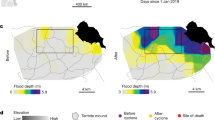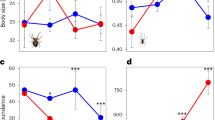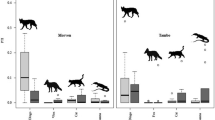Abstract
Because apex predators exert considerable influence on the structure and function of top-down ecosystems1,2,3, their responses to climate may shape responses at lower trophic levels4. Previous reports of trophic cascades and ecosystem dynamics induced by predators have focused on changes in their abundance5,6,7,8, whereas we investigated whether changes in predator behaviour could precipitate cascades of similar ecological scale. Here we report the ecological consequences of predator behavioural response to global climatic variation using 40 years of data on wolf predation from Isle Royale, USA, where wolves limit abundance of moose9, which limit productivity of fir trees10. In response to increases in winter snow related to the North Atlantic Oscillation, wolves hunted in larger packs and, consequently, tripled the number of moose killed per day compared with less snowy years when they hunted in smaller packs. Following increased predation rates, moose abundance declined, and, following release from heavy browsing, growth of understory fir increased. Hence, cascading behavioural responses of apex predators may be a substantial link in the pathway from climatic change to ecosystem function.
This is a preview of subscription content, access via your institution
Access options
Subscribe to this journal
Receive 51 print issues and online access
$199.00 per year
only $3.90 per issue
Buy this article
- Purchase on Springer Link
- Instant access to full article PDF
Prices may be subject to local taxes which are calculated during checkout


Similar content being viewed by others
References
Estes,J. A. & Palmisano,J. F. Sea otters: their role in structuring nearshore communities. Science 185, 1058–1060 (1974).
Spiller,D. A. & Schoener,T. W. A terrestrial field experiment showing the impact of eliminating top predators on foliage damage. Nature 347, 469–472 (1990).
McPeek,M. A. The consequences of changing the top predator in a food web: a comparative experimental approach. Ecol. Monogr. 68, 1–23 (1998).
Sanford,E. Regulation of keystone predation by small changes in ocean temperature. Science 283, 2095–2097 (1999).
Paine,R. T. Food web complexity and species diversity. Am. Nat. 100, 65–75 (1966).
Paine,R. T. Intertidal community structure: Experimental studies on the relationship between a dominant competitor and its principal predator. Oecologia 15, 93–120 (1974).
Estes,J. A. & Duggins,D. O. Sea otters and kelp forests in Alaska: generality and variation in a community ecological paradigm. Ecol. Monogr. 65, 75–100 (1995).
Estes,J. A., Tinker,M. T., Williams,T. M. & Doak,D. F. Killer whale predation on sea otters linking oceanic and nearshore ecosystems. Science 282, 473–476 (1998).
Post,E. & Stenseth,N. C. Large-scale climatic variability and population dynamics of moose and white-tailed deer. J. Anim. Ecol. 67, 537–543 (1998).
McLaren,B. E. & Peterson,R. O. Wolves, moose, and tree rings on Isle Royale. Science 266, 1555–1558 (1994).
Peterson,R. O. Wolf Ecology and Prey Relationships on Isle Royale (National Park Services Scientific Ser. No. 11, Washington DC, 1977).
Peterson,R. O., Page,R. E. & Dodge,K. M. Wolves, moose, and the allometry of population cycles. Science 224, 1350–1352 (1984).
McLaren,B. E. & Janke,R. A. Seedbed and canopy cover effects on balsam fir seedling establishment in Isle Royale National Park. Can. J. For. Res. 26, 782–793 (1996).
Brandner,T. A., Peterson,R. O. & Risenhoover,K. L. Balsam fir on Isle Royale: effects of moose herbivory and population density. Ecology 71, 155–164 (1990).
McInnes,P. F., Naiman,R. J., Pastor,J. & Cohen,Y. Effects of moose browsing on vegetation and litter of the boreal forest, Isle Royale, Michigan, USA. Ecology 73, 2059–2075 (1992).
Pastor,J., Dewey,B., Naiman,R. J., McInnes,P. F. & Cohen,Y. Moose browsing and soil fertility in the boreal forests of the Isle Royale National Park. Ecology 74, 467–480 (1993).
Hurrell,J. W. Decadal trends in the North Atlantic Oscillation: regional temperatures and precipitation. Science 269, 676–679 (1995).
Mech,L. D., McRoberts,R. E., Peterson,R. O. & Page,R. E. Relationship of deer and moose populations to previous winters' snow. J. Anim. Ecol. 56, 615–627 (1987).
Post,E. & Stenseth,N. C. Climatic variability, plant phenology, and northern ungulates. Ecology 80, 1322–1339.
Peterson,R. O., Thomas,J. N., Thurber,J. M., Vucetich,J. A. & Waite,T. A. Population limitation and the wolves of Isle Royale. J. Mamm. 79, 828–841 (1998).
Thurber,J. M. & Peterson,R. O. Effects of population density and pack size on the foraging ecology of gray wolves. J. Mamm. 74, 870–889 (1993).
Schmidt,P. A. & Mech,L. D. Wolf pack size and food acquisition. Am. Nat. 150, 513–517 (1997).
Peterson,R. O. & Page,R. E. The rise and fall of Isle Royale wolves, 1975–1986. J. Mamm. 69, 89–99 (1988).
Peterson,R. O. & Allen,D. L. Snow conditions as a parameter in moose-wolf relationships. Le Naturaliste Canadien 101, 481–492 (1974).
Kelsall,J. P. Structural adaptations of moose and deer for snow. J. Mamm. 50, 302–310 (1969).
Molvar,E. M. & Bowyer,R. T. Moose herbivory, browse quality, and nutrient cycling in an Alaskan treeline community. Oecologia 94, 472–479 (1993).
Mech,L. D. The Wolf (Univ. Minnesota Press, 1970).
Ben-David,M., Bowyer,R. T., Duffy,L. K., Roby,D. D. & Schell,D. M. Social behavior and ecosystem processes: river otter latrines and nutrient dynamics of terrestrial vegetation. Ecology 79, 2567–2571 (1998).
Beckerman,A. P., Uriarte,M. & Schmitz,O. J. Experimental evidence for a behavior-mediated trophic cascade in a terrestrial food chain. Proc. Natl Acad. Sci. USA 94, 10735–10738 (1997).
Schmitz,O. J., Beckerman,A. P. & O'Brien,K. M. Behaviorally mediated trophic cascades: effects of predation risk on food web interactions. Ecology 78, 1388–1399 (1997).
Acknowledgements
We thank the U.S. National Science Foundation for grants to E.P. and R.O.P., the US National Park Service and Earthwatch for grants to R.O.P. and the Norwegian Science Council (NFR) for a grant to N.C.S. We thank G.-P. Saetre for discussions.
Author information
Authors and Affiliations
Corresponding author
Rights and permissions
About this article
Cite this article
Post, E., Peterson, R., Stenseth, N. et al. Ecosystem consequences of wolf behavioural response to climate. Nature 401, 905–907 (1999). https://doi.org/10.1038/44814
Received:
Accepted:
Issue Date:
DOI: https://doi.org/10.1038/44814
This article is cited by
-
Warming causes contrasting spider behavioural responses by changing their prey size spectra
Nature Climate Change (2024)
-
Predator behaviour is altered by climate warming effects rippling through food webs
Nature Climate Change (2024)
-
Climate change increases predation risk for a keystone species of the boreal forest
Nature Climate Change (2020)
-
Insights about collective decision-making at the genetic level
Biophysical Reviews (2020)
-
Social organization of boreal woodland caribou (Rangifer tarandus caribou) in response to decreasing annual snow depth
Mammal Research (2019)
Comments
By submitting a comment you agree to abide by our Terms and Community Guidelines. If you find something abusive or that does not comply with our terms or guidelines please flag it as inappropriate.



